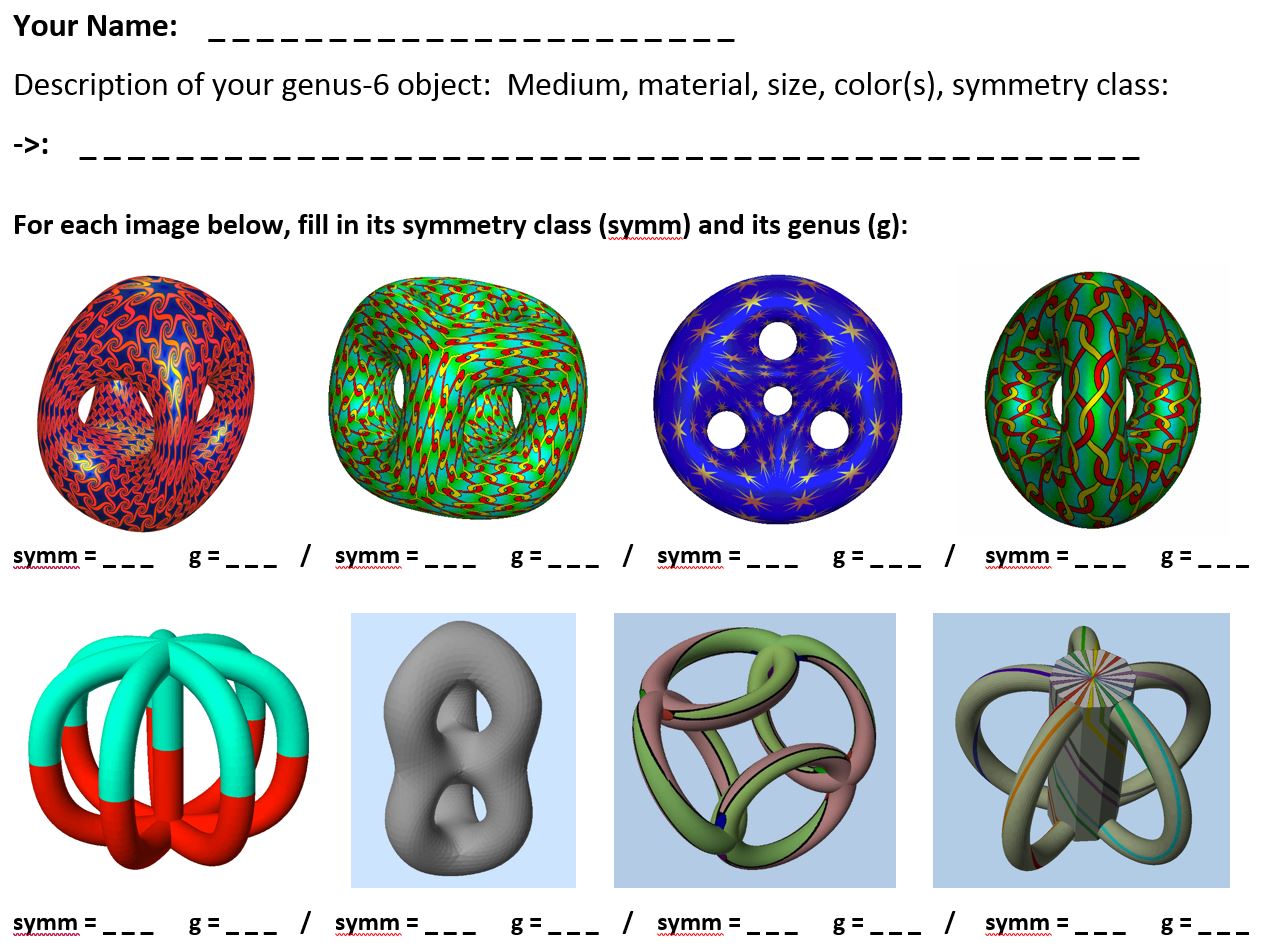CS 39R: Symmetry & Topology
Lecture #4 -- Mon. 9/25, 2017.
PREVIOUS <- - - - > CS 39R HOME < - - - - > CURRENT < - - - - > NEXT
Preparation:
Design
a genus-6 object of high symmetry:
Present your design as a physical model, using: clay, paper,
styro-foam, pipe cleaners, . . ., or as a
computer model; or as a very nice drawing.
Be prepared to tell us what its symmetry is.
Warm-up:
Discuss your genus-6 object and its
symmetries with your neighbors.
If you all come to an agreement, try to find a
general formula that
specifies the maximal amount of symmetry that a
handle-body of genus g may have.
Brief Review of the 14 Symmetry Families of Compact (of finite
size) 3D Objects:
Check the posters on the wall and or the these two
charts:
7
families of rotational groups based on the 7 friezes wrapped
around a cylinder: Cn, Dn, S2n, Dnd, Cnh, Cnv. Dnh.
7
groups of "really 3D" symmetries based on the Platonic and
Archimedean solids.
Visualization of Symmetry Groups Using Shape Generator Programs:
Jane Yen and C. H. Séquin: "Escher Sphere
Construction Kit" Presentation at I3D conference
(PPT)
The Topology of Handle-Bodies:
Examples of simple "handle-bodies":
(g=1; g=2; g=3; g=7):

These are all equivalent definitions of "genus"
(in this particular context):
How many tunnels are there through this (volumetric) body?
How many handles are attached to a simple spherical blob?
(How many
"arms" need to be cut so that there are no longer any loops, but
the object is still connected?)
How many closed boundary loops can be drawn on this surface that
do not yet partition it into separate regions?
(You can still
go from any point to any other point without crossing any of
those boundary loops).
Worksheet: The Genus and Symmetries of
Handle-bodies.

The surfaces of these handle-bodies
are 2-manifolds.
A 2-Manifold is a mathematical surface where every
small neighborhood has the connectivity of a small disk,
(or half-disks, if the surface has holes and borders);
but no "multi-leaf" branching as at the spine of a book!.
Surfaces of handle-bodies happen to be orientable and
2-sided:
They have an "inside" towards the material of the body and an
"outside" towards the surrounding air.
From now on, we focus on this infinitely thin mathematical
surfaces.
So far these surfaces were free of "holes" or "punctures."
Introducing "Punctures":
If a small disk-like patch is removed
from a 2-manifold, its genus remains the same;
but it now has a "puncture" with a "border".
A thin spherical shell with n holes is still a genus_0
surface, but one with n punctures (with n
borders).
Note: Do not confuse this with drilling tunnels
into a thick-shelled, hollow (volumetric) spherical ball!
A single such tunnel turns the thick-walled sphere into a "fat
disk" -- which is a lump of genus 0.
Drilling t such tunnels into a thick-walled sphere turns
this into a volumetric object with a surface of genus t-1.
(Asking for the genus of a thick-walled sphere without any
tunnels, is not appropriate, because it has TWO surfaces: inner
and outer!)
Single-sided, Non-orientable 2-Manifolds:
Moebius-Bands and Klein Bottles: PPT
What is a Moebius band?
Moebius bands come in many different forms...
These are NOT Moebius bands...
What is a Klein bottle?
Klein bottles also come in many different forms...
The Surface Classification Theorem: PPT
All
2-manifolds can be characterized topologically by just THREE
parameters:
its sidedness (1 or 2); its number of borders (0 ...
infinity); its genus (0 ... infinity).
==> To be continued ... Se also: Video:
"From
Klein Bottles to Super-bottles"
New Homework Assignments:
Fill in the blanks in the Work-sheet
on Surface Classification
(This may be hard. Do as well
as you can. Do not despair. We will go over this in
detail next lecture.)
Also:
Watch the video: "From
Klein Bottles to Super-bottles"
Due by e-mail before: 9am,
Oct. 2, 2017
PREVIOUS <- - - - > CS 39R HOME < - - - - > CURRENT < - - - - > NEXT
Page Editor: Carlo H. Séquin